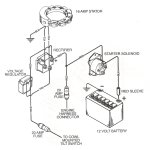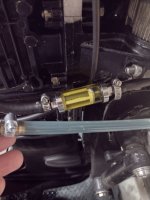chipperstrauss
Cadet
- Joined
- Jun 5, 2019
- Messages
- 14
I'm back after a couple year hiatus. Here's my story, it's sad but true... the last two cruises ended with engine problems. The first was a faulty ground connection on the battery terminal causing low voltage and a dead engine. I fixed that. The second time I was able to limp back to the launch ramp because the engine would abruptly stop while cruising. At that point, I chose to rebuild the carburators which took many months because life got in the way. I finally completed the carb rebuilds and went to the lake to adjust. I saw bubbly foamy stuff coming out the upper right engine mount. So, I chose to pull the power head (after fabricating a hoist in my garage now boat barn) thinking there was a gasket break. I also chose to rebuild the water pump. A couple months ago, the engine was finally back together. I have adjusted the carbs so it will idle but have not fine tuned the idle mixture. I did attempt to take a spin around the small bay in our lake... to my chagrin, that same stalling symptom remains. Here's a link to the video https://photos.app.goo.gl/foSKL7ZsRbw1sqWM7
I received a quick response from my mechanic who suspects a fuel issue of some kind. So, where to start. I reviewed several videos on fuel issues. One question I came up with is:
How many fuel filters are OK in the fuel line? Right now, I have a water separator filter close to the main tank, two in-line filters (one before the bulb and one just past the fuel line connection, and the fourth being the original filter just after the fuel pump. Could the issue be that the pump can't pull fuel through the 3 upstream filters and push it through the stock engine filter?
Another question I have is what mechanically stops the fuel flow when squeezing the bulb? I can't find an anser to that and assume it's the float valves inside the carbs. Am I right or is there something else?
My exposed fuel line is the gray hose but is new within the past two years. I plan to replace it with black fuel line which is more impervious to ethanol. I read a recommendation that one should use premium gas because it has a significantly lower ethanol percentage. Is that the consensus among you all?
I would like a procedure to trouble shoot the fuel issues prior to pulling the carbs off again. Doing that requires quite a bit of dissassembly.
I hope you all enjoy offerring online mechanic's advice as much as I enjoy the feeling of success when working these older outboards.
I received a quick response from my mechanic who suspects a fuel issue of some kind. So, where to start. I reviewed several videos on fuel issues. One question I came up with is:
How many fuel filters are OK in the fuel line? Right now, I have a water separator filter close to the main tank, two in-line filters (one before the bulb and one just past the fuel line connection, and the fourth being the original filter just after the fuel pump. Could the issue be that the pump can't pull fuel through the 3 upstream filters and push it through the stock engine filter?
Another question I have is what mechanically stops the fuel flow when squeezing the bulb? I can't find an anser to that and assume it's the float valves inside the carbs. Am I right or is there something else?
My exposed fuel line is the gray hose but is new within the past two years. I plan to replace it with black fuel line which is more impervious to ethanol. I read a recommendation that one should use premium gas because it has a significantly lower ethanol percentage. Is that the consensus among you all?
I would like a procedure to trouble shoot the fuel issues prior to pulling the carbs off again. Doing that requires quite a bit of dissassembly.
I hope you all enjoy offerring online mechanic's advice as much as I enjoy the feeling of success when working these older outboards.























